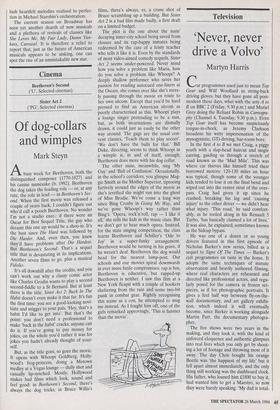Television
'Never, never drive a Volvo'
Martyn Harris
Car programmes used just to mean Top Gear and Wilf Woollard in string-back driving gloves, but they have gone all post- modern these days, what with the arty A to B on BBC 2 (Friday, 9.30 p.m.) and Muriel Grey doing the Reliant Robin in Camogra- phy (Channel 4, Tuesday, 9.30 p.m.). Even Top Gear itself has become suspiciously tongue-in-cheek, as Jeremy Clarkson broadens his witty impersonation of the mysogynistic, GTi-driving, bar-room bore.
In the first A to B we met Craig, a piggy youth with a slap-head haircut and single earring, guiding us through a stretch of road known as the 'Mad Mile'. This was where car thieves like himself tried their borrowed motors: 120-130 miles an hour was typical, though some of the younger kids tended to lose it on the final bend and wiped out into the centre strut of the over- pass. Craig had given it up since he crashed, breaking his leg and 'causing injury' to the other driver — we didn't hear what injury. 'This road,' he said comfort- ably, as he tooled along in his Renault 5 Turbo, 'has basically claimed a lot of lives.' It was also, he explained, sometimes known as the Sidcup bypass.
He was one of a dozen or so young drivers featured in this first episode of Nicholas Barker's new series, billed as a sequel to Signs Of The Times — Barker's cult programmes on taste in the home. It adopts the same techniques of minute observation and heavily authored filming, where real characters are rehearsed and directed like professional actors, and regu- larly posed for the camera in frozen set- pieces, as if for photographic portraits. It gives a feel half way between fly-on-the- wall documentary, and art gallery exhibi- tion, which indeed it will eventually become, since Barker is working alongside Martin Parr, the documentary photogra- pher.
The five shows were two years in the making, and they look it, with the kind of unforced eloquence and authentic glimpses into real lives which you only get by shoot- ing a lot of footage and throwing most of it away. The day Chris bought his orange Beetle was 'the happiest of my life' but it fell apart almost immediately, and the only thing still working was the dashboard clock. His father, who loaned him /1800 to buy it, had wanted him to get a Maestro, so now they were barely speaking. 'My dad is total- ly different to me in every way. He is a teacher, he votes Labour and he stays in at night and watches documentaries. I vote Conservative, I go down the pub, but most of all I would never, ever drive a Volvo estate.'
Sally had a receding chin; wore a ruched velvet hairband on her wrist and drove a 2CV called Brian, with a silver snail on the bonnet — bought for her by daddy: 'Brian is a car which suits me perfectly: funny, a bit scatty looking, and not grown-up at all.' She had to call the AA a while ago, 'and it turned out I hadn't actually put any oil in it, so the insides had all scrunlded up'.
James had asked for a Porsche when he was five, but his father had said he could only have a Volvo. 'Then I'll wait until you die and sell it for a Porsche,' he replied. In the event he settled for a Renault Clio 16V with three oil gauges CI told him the 16V just meant it had better seat covers and he was quite happy with that.') The young drivers were filmed in their cars, burning down the road to adulthood, while their parents were filmed on the fam- ily sofa wringing their hands. The vehicles were just vehicles for mini-dramas of family life: the children who couldn't wait to leave home, and the children you can never get rid of. In ten years' time Sally imagined herself driving a Range Rover 'with oodles of children and dogs in the back'. Craig the car thief's mum thought he would be driv- ing a 'bigger and better car, and living in a penthouse'. I would hope it's a 12-year-old Datsun and a council house — preferably not within 50 miles of mine.



























































 Previous page
Previous page